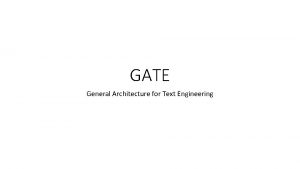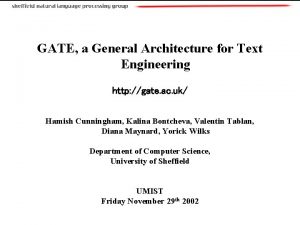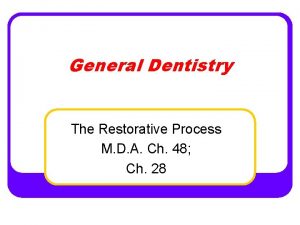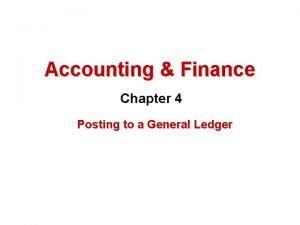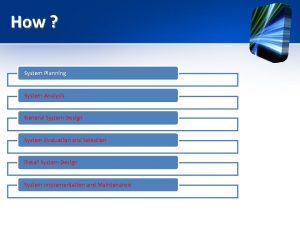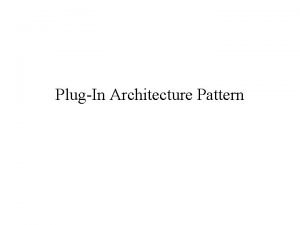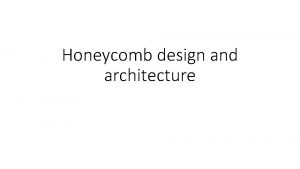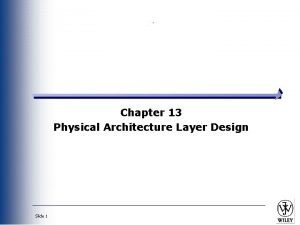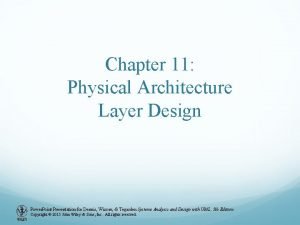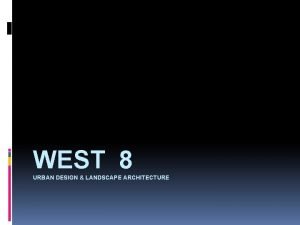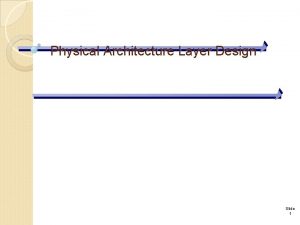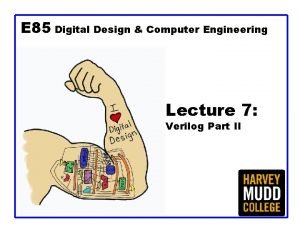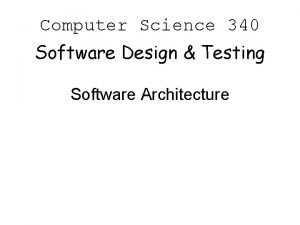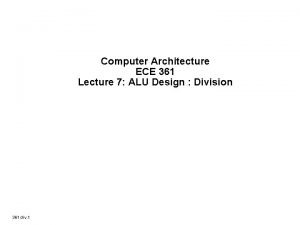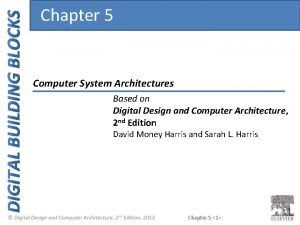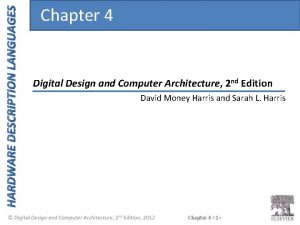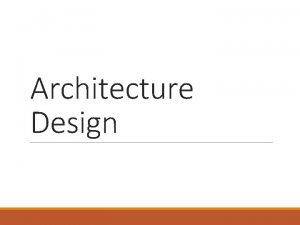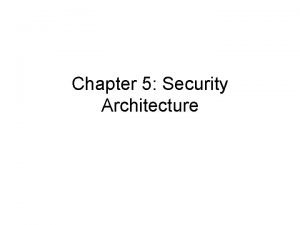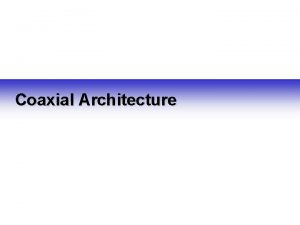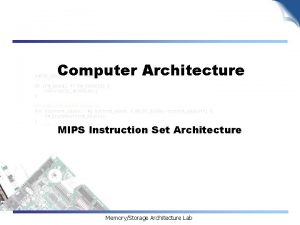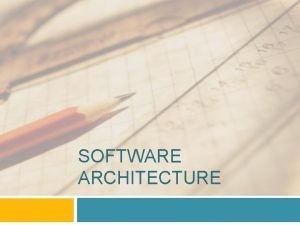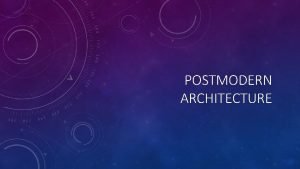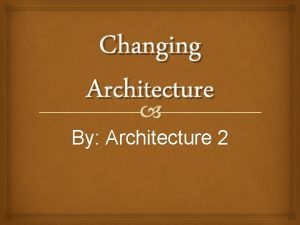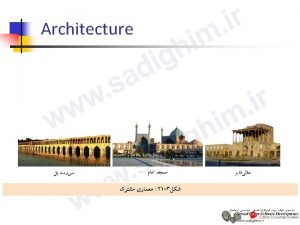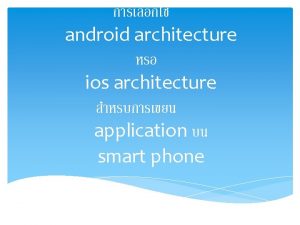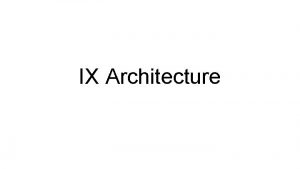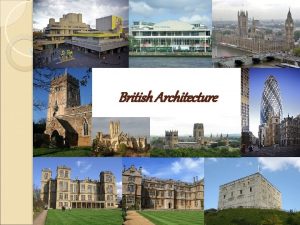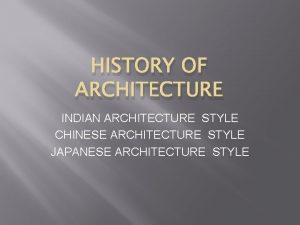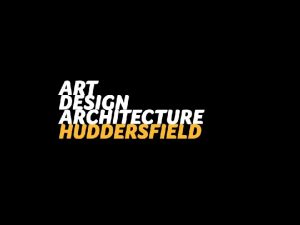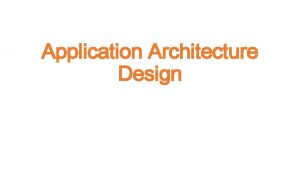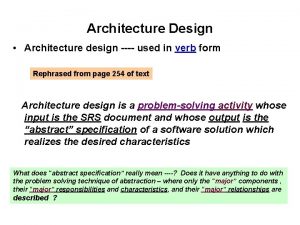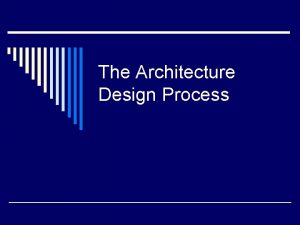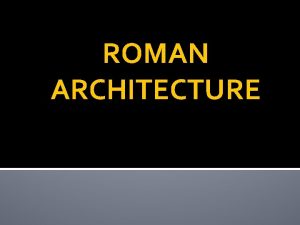Chapter 6 Architecture Design DESIGN IN GENERAL Design









































- Slides: 41

Chapter 6: Architecture Design

DESIGN IN GENERAL Design is both a verb and a noun Design is process results in the creation of design – a description of a desired end state Designing means making decisions to achieve goals and statisfy requirements and constraints For example, why do traditional houses in China look different from those in Switzerland or Algeria?

DESIGN IN GENERAL The arhictectures of these styles of houses have envolved over the centuries to reflect their unique sets of goals, requirements, and constraints China feature symmetric enclosures, sky wells to increase ventilation, southfacing courtyards to collect sunlight and provide protection from cold north winds, and so forth

DESIGN IN SOFTWARE ARCHITECTURE Architecture design for software systems is not different than design in general, involves with: i. Making decision ii. Working with available skills and materials iii. To satisfy requirements & contraints In architecture design, we make a decisions to transform our design purpose, requirements, constraints, and architectural concerns Also called architecture drivers into structures

DESIGN IN SOFTWARE ARCHITECTURE Design concepts Design purpose <<select and instantiates>> Quality attribute <<uses>> Primary functionality <<produces>> Architectural concern Constraints Architectural Drivers Candidate design decisions The Architect (Documented) Structures resulting from design decision

Architectural Design Brady Booch has said, “All architecture is design, but not all design is architecture” What makes a decision “architectural”? A decision is architectural if it has non-local consequences and those consequences matter to the achievement of an architectural driver

Element Interaction Design The architect will focus on the primary functionality of the system What makes a use case primary? A combination of business importance, risk and complexity considerations feed into this designation More realistically, a small number of use cases provide the most fundamental business value or represent the greatest risk Every system has many more use cases, beyond the primary ones, that need to be satisfied The elements that support these noprimary use cases and their interfaces are identified as part of what we call element interaction design

Element Interaction Design This level of design usually follows architectural design These elements can be units of work (i. e. modules) assigned to an individual or to a team, so this level of design is important for defining not only how nonprimary functionality is allocated, but also for planning purposes (i. e. team formation and communication, budgeting, outsourcing, release planning, unit and integration test planning) Depends on the scale and complexity of the syste, the architect should be involved in element interaction design, either directly or in auditing role

Element Internal Design A third level of design follows interaction design, which we call element internal design Conducted as part of the element development activities, the internals of the elements identified in the previous design level are established, so as to satisfy the element’s interface

WHY IS ARCHITECTURAL DESIGN SO IMPORTANT? Initial architecture is critical for project proposals Wtihout doing some architecture thinking and some early design work, you cannot confidently predict project cost, schedule, and quality Architecture will determine the key approaches for achieving architectural drivers, the gross work-breakdown structure, and the choice of tools, skills and technologies needed to realize the system

WHY IS ARCHITECTURAL DESIGN SO IMPORTANT? Simple, why would anyone ever “invest” in architecture? The answer is simple, without architecture, the benefits that the system is supposed to bring will be far harder to realize

ARCHITECTURAL DRIVERS Before connecting design with ADD (or with any other design method, for that matter), you need to think about what you are doing and why We categorize these “what” and “why” questions as architectural drivers These drivers includes a design purpose, quality attributes, primary functionality architectural concerns, and constraints

Design Purpose First, you need to clear about the purpose of the design that you want to achieve When and why are you doing this architecture design? Which business goals is the organization most concerned about this time? The architect should be clear about these goals and should communicate them and establish a clear design purpose before beginning the design process

Quality Attributes Quality attributes are defined as being mesurable or testable properties of a system that are used to indicate how well the system satisfies the needs of its stakeholders Quality attributes must be measure for example: i. How fast should the function be? ii. How secure should the function be? iii. How modifiable should be function be?

Quality Attributes To address this problem, we use a scenario to describe a quality attribute requirement A quality attribute scenario is a short description of how a system is required to respond to some stimulus For example, we might annote the functional requirement given earlier as follow: - q The game shall change view modes in < 500 ms when the users presses <C> button q A scenario associates a stimulus (in this case, the pressing of the <C>) with a response (changing the view mode) that is measured using a response measure (<500 ms) A complete quality attribute scenario adds three other parts: - the source of stimulus (i. e. user), the artifact (i. e. entire system), and the environment. Refer Fig. 6. 1

Quality Attributes Stimulus Source of Stimulus Artifact Environment Fig. 6. 1. The six parts of a quality attribute scenario Response measure

Primary Funtionality Functionality is the ability of the system to do the work for which it was intended Two important reasons why you need to consider primary functionality when designing an architecture: i. You need to think how functionality will be allocated to elements (usually modules) to promote modifiability or reusability, and also work assignments ii. Some quality attribute scenarios are directly connected to primary functionality in the system. For example, in a movie streaming application, one of the primary use cases is to watch a movie. This use cases is associated with a performance quality attribute scenario such as “One the user presses play, the movie should begin streaming in no more than 5 seconds”

Architectural Concerns Architectural concerns encompass additional aspects that need to be considered as part of architectural design There are several types of concerns: i. General access: These are ‘broad’ issues that one deals with in creating the architectue, such as startup and shutdown, the allocation of modules to teams, supporting delivery, and updates. ii. Specific concerns: These are more detailed system-internal issues such as exception management, authorization, dependency management, configuration, logging, authentication, caching, and so forth that are common across large number of applications iii. Internal requirements: These requirements are usually not specified explicitly in traditional requirement documents, as customer usually seldom express them iv. Issues: For instance, an architecture evaluation may uncover a risk that requires some changes to be performed in the current design

Constraints You need to catalog the contraints on development as part of the architectural design process These contraints may take the form of mandated technologies, other systems with which your system needs: i. To interoperate or integrate ii. Laws and standards that must be complied with iii. The abilities and availability of your developers iv. Deadlines that non-negotiable v. Backward compatibility with older versions of systems

DESIGN CONCEPTS: The Building Blocks for Creating Structures Design is not random, but rather is planned, intentional, rational and directed For example, some well-documented design principles are oriented toward the achievement of specific quality attributes: To help achieve high modifiability, aim for good modularity, which means high cohesion and low coupling To help achieve high availability, avoid having any single point of failure To help achieve scalability, avoid having any hard-coded limits for critical resources To help achieve security, limit the points of access to critical reources To help achieve testability, externalize state

DESIGN CONCEPTS: The Building Blocks for Creating Structures Elements must consider in design concepts such as: q Reference architecture q Architecture design patterns q Deployment patterns q Tactics q Externally developed components

Reference Architecture Blueprints that provide an overall logical structure for particular types of applications A reference architecture is a reference model mapped onto one or more architectural patterns An example of a reference architecture for the development of web applications is shown in Fig 6. 2

Reference Architecture Client Browser Cli Server (from business layer) Application Facade * Business Workflow Business Entities Business Logic (from data layer) Data access Helpers and Utilities Security UI Process Logic Operational Management User interface Communication Cross-Cutting (from presentation layer) Service Agents * = optional component Data sources Other systems Fig. 6. 2 Example reference architecture for the development of web applications

Architectural Design Patterns Design patterns are conceptual solutions to recurring design problems that exists in a defined context Design patterns focuses on decisions at the object scale, including instantiation, structuring, and behavior, today there are catalog with patterns that address decisions at varying levels of granularity

Architectural Design Patterns Fig. 6. 3 shows an example architectural pattern that is useful for structure the system, the Layers pattern When you choose a pattern such as this one, you must decide how many layers you will need for your system Fig. 6. 4 shows a pattern to support concurrency, which is useful to increase performance This pattern, too, needs to be instantiated – that is, it needs to be adapt to the specific problem and design context

Architectural Design Patterns Service. B Service. A Service. C Layer 1 Service. G Service. F Layer 2 Service. K Service. M Service. L Service. N Layer 3 Lagend: Layer Service Interface Calls/Invokes Figure 6 -3. The layers pattern for structuring an application from Pattern-Oriented Software Architecture

Architectural Design Patterns Synchronous service layer Method 1 Queueing layer <<message>> Remove <<message>> Insert Network I/O <<message>> Asynchronous service layer <<message>> Method Figure 6 -4. The half-sync/half-async pattern to support Concurrency from pattern-oriented software architecture

Deployment Patterns Another type of pattern that we prefer to consider separately is deployment patters. These patterns provide models on how to physically structure that system to deploy it Some patterns such as the one shown in Fig. 6. 5 are useful to eastablish an initial physical structure of the system in terms of tiers

Deployment Patterns Client tier Client Web tier Web Server Fig. 6. 5: Four tier deployment pattern from the Microsoft Application Architecture Guide Business logic tier App Server Database tier Database

Tactics Architects can use collections of fundamentals design techniques to achieve a response for particular quality attributes We call these architectural design primitives tactics Tactics, like design patterns, are techniques that architects have been using for years We do not invent tactics, but simply capture what architects actually have done in practice, over the decades, to manage quality attribute response goals

Tactics Events arrive Tactics to control performance Response generated within time constraints Fig. 6. 6: Tactics mediate events and responses

Tactics are design decisiobs that influence the control of a quality attribute response For example, if you want to design a system to have low latency or high throughput, you could make a set of design decisions that would mediate the arrival of events (request for service), resulting in responses that are produced within some time constraints (Fig. 6. 6)

Tactics are both simpler and more primitive than patterns They focus on the control of a single quality attribute response Patterns, in contrast, typically focus on resolving and balancing multiple forces, that is, multiple quality attribute goals Tactics provide a top-down way of thinking about design A tactics categorization begins with a set of design activities objectives related to the achievement of a quality attribute, and presents the architect with a set of options from which to choose

Tactics For example, in Fig 6. 7, the design objectives for performance are “Control Resource Demand” and “Manage Resources” An architect who wants to create a system with “good” performance needs to choose one or more of these options That is, the architect needs to decide if controlling resource demand is feasible, and if managing resources is feasible In some systems, the events arriving at the system can be managed, prioritized, or limited in some way Within the “Manage Resources” category, an architect might choose to increase resources, introduce concurrency, maintain multiple copies of computations, maintain multiple copies of data, and so forth

Tactics Performance Tactics Control Resource Demand Manage Resource Event Response generated within Time constraints Arrive q Manage sampling rate q Limit event response q Prioritize events q Reduce overhead q Bound execution times q Increase resource efficiency q Increase resources q Introduce concurrency q Maintain multiple copies of computations q Maintain multiple copies of data q Bound queue sizes q Schedule resource Fig. 6. 7 performance tactics from software architecture in practice

Externally Developed Components Patterns and tactics are abstract in nature Woever, when you are designing a sotware architecture, you need these design concepts concrete and closer to the actual implementation Several types of externally developed components exist: q Technology families: - A technology family represents a group of specific technologies with common functional purposes. An example is RDBMS or an objectoriented to relational mapper (ORM) q Products: - A product refers to a self-contained functional piece of software that can be integrated into the system that is being designed and that requires only minor configuration or coding. An example is a relational database management system such as Oracle

Externally Developed Components Several types of externally developed components exist: q Application frameworks: - An application framework is a reusable software element, constructed out of patterns and tactics, that provides generic functionality addressing recurring domain and quality attribute concerns across a broad range of application. A frawework example is Hibernate, which is used to perform object-oriented to relational mapping in Java. q Platform: - A platform provides a complete infrastructure upon which to build and execute applications. Example of platforms include Java, Net, or snf Google Cloud

Externally Developed Components The selection of externally developed components, which is key aspect of the design process, can be challenging task because of their extensive number Here are few criteria you should consider: Problem that is addresses: - Is it something specific such as a framework for objectoriented to relational mapping or something more generic, such as a platform? Cost: - What is cost of licence and, if it is free, what is the cost of support & education? Type if license: - Does it have a license that is compitable with the project goals? Support: - Is it well supported? Maturity: - Is it a technology that just appeared on the market, which may be exciting but still relatively unstable or unsupported?

Externally Developed Components Here are few criteria you should consider: q Compatibility and ease of integration: - Is it compitable with other technologies used in the project? q Support for critical quality attributes: - Dies it limit attributes such as performance? Is it secure and robust? q Size: - Will the use of the technology have a negative impact on the size of the application under development?

ARCHITECTURE DESIGN DECISION Design is the process of making decisions But the act of making a decision is a process, not a moment in time Experienced architects, when faced with a design challenge, typically entertain a set of “candidate” decisions In early stages of design, decisions foucs on the biggest, most critical choices that will substantial downstream consequences: reference architectures, major technologies, and patterns

SUMMARY The idea of design as a set of decisions to satisfy requirements and constraints Architectural design is guided by certain principles For example, to achieve good modularity, high coupling, and low cohesion, the wise architect will probably include some form of layering in the architecture being designed From this foundations, an architecture can be confidently and precictably constructed
 Diferencia entre gran plano general y plano general
Diferencia entre gran plano general y plano general Where did general lee surrender to general grant?
Where did general lee surrender to general grant? General architecture for text engineering
General architecture for text engineering General architecture for text engineering
General architecture for text engineering Gate general architecture for text engineering
Gate general architecture for text engineering Architecture business cycle
Architecture business cycle Call and return architecture in software architecture
Call and return architecture in software architecture Modular architecture vs integrated architecture
Modular architecture vs integrated architecture Integral product architecture example
Integral product architecture example Bus design in computer architecture
Bus design in computer architecture Black's classification
Black's classification Chapter 38 assisting with a general physical examination
Chapter 38 assisting with a general physical examination Posting to a general ledger chapter 4
Posting to a general ledger chapter 4 Body structure general survey
Body structure general survey Normal vital signs for all age groups
Normal vital signs for all age groups Chapter 6 general anatomy
Chapter 6 general anatomy Chapter 8 bonding general concepts answers
Chapter 8 bonding general concepts answers Chapter 4 posting to a general ledger
Chapter 4 posting to a general ledger The general and special senses chapter 9
The general and special senses chapter 9 Chapter 6 general anatomy and physiology
Chapter 6 general anatomy and physiology General consideration of machine design
General consideration of machine design General system design
General system design General design process
General design process Steam shell and tube heat exchanger
Steam shell and tube heat exchanger Aadl tutorial
Aadl tutorial Plugin design pattern java
Plugin design pattern java Memory system design in computer architecture
Memory system design in computer architecture Honeycomb design architecture
Honeycomb design architecture Digital design and computer architecture
Digital design and computer architecture Physical architecture layer design
Physical architecture layer design Physical architecture layer design
Physical architecture layer design Architectural design objectives examples
Architectural design objectives examples West 8 urban design & landscape architecture
West 8 urban design & landscape architecture Physical architecture layer design
Physical architecture layer design Digital design and computer architecture
Digital design and computer architecture What is component diagram in software engineering
What is component diagram in software engineering Alu design in computer architecture
Alu design in computer architecture Digital design and computer architecture
Digital design and computer architecture Digital design and computer architecture
Digital design and computer architecture Atm design architecture
Atm design architecture Architecture design principles
Architecture design principles Architecture design principles
Architecture design principles



